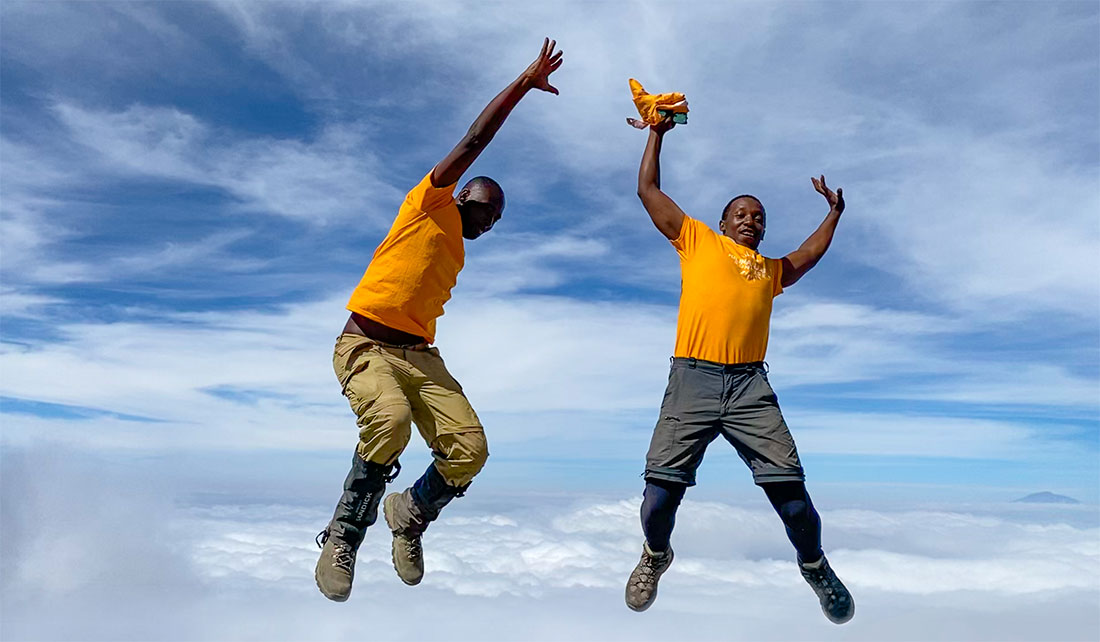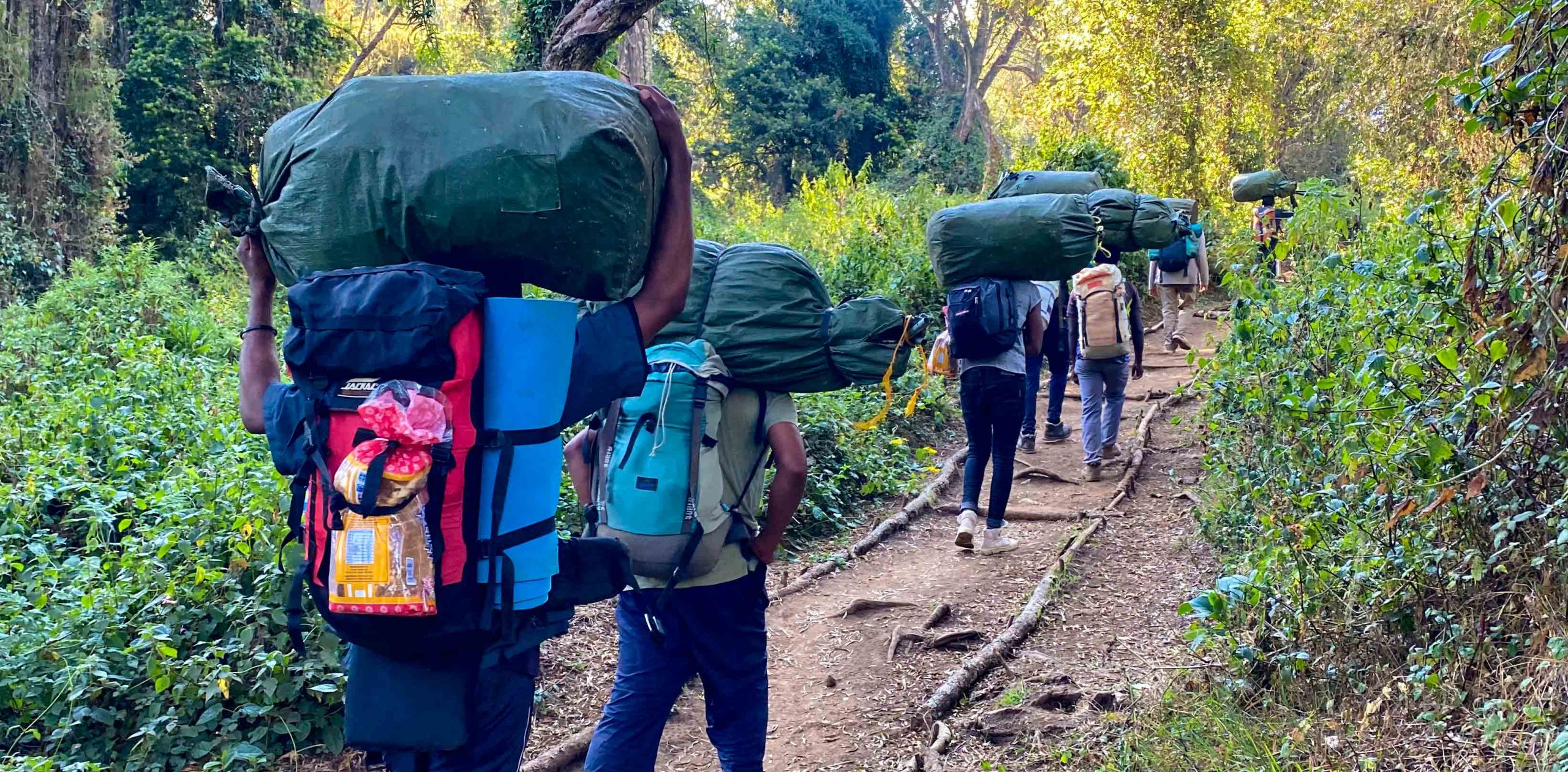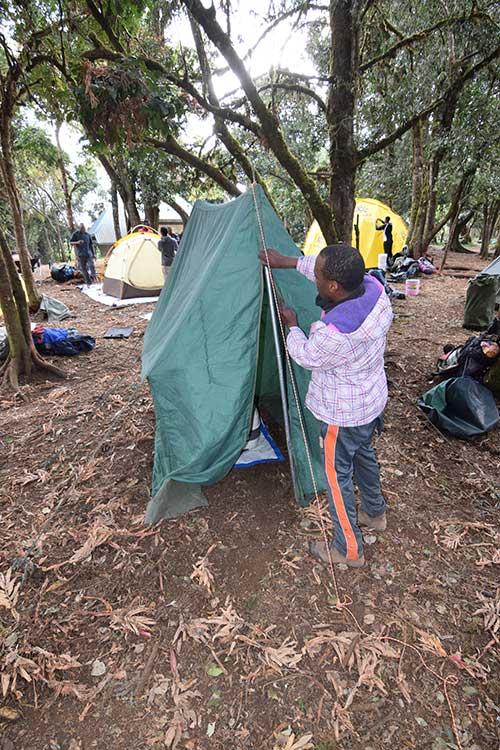
Unfortunately, it is not possible to climb Kilimanjaro without a guide. Kilimanjaro National Park has made it a requirement that all trekkers are accompanied by a registered and licensed guide. Trekkers need to register with the Parks Authority before beginning their trek. They also need to sign in at each camp along their chosen route.
Since the park requires a guide to be with you at all times, how many guides do you have? How many people will be climbing with you and how many people will make up your mountain crew?
The number of crew members depends on the company you climb with, how reputable the operator is, and the number of people in your group.
Climbing Kilimanjaro is a hike that just about anyone who is reasonably fit can do. But despite your fitness level, you cannot trek Kilimanjaro by yourself. In 1991 the Kilimanjaro National Park authorities made it mandatory to climb Kilimanjaro with a licensed operator.
Furthermore, trekkers are required to be accompanied throughout their hike by the guide supplied by the operator they booked with. Even after this law was enacted, many people attempted to make for the summit by skirting the law and going at it alone. This led to tall tales of wild animal encounters and episodes of fleeing from Park Rangers. The park has now tightened these restrictions and heightened security so these embellished tales are mostly non-existent.
If you do try to climb it alone, you are risking your life and are also stealing from the livelihood of one of the poorest countries in the world.
Climbing Kilimanjaro is expensive, but the costs to maintain such a large park and to pay the mountain crew is definitely worth every penny. Don’t believe us? Book your trip and find out what an amazing life-changing experience awaits you.
Kilimanjaro Sunrise Mountain Crew
Since we are experts on the mountain, but not experts on the other guiding companies, we are going to tell you what we offer our clients.
First of all, we have a 2-to-1 client-to-guide ratio for all of our climbs regardless of the number of people and whether it is a group or private climb. This is the highest ratio on the mountain. Budget operators may have only one guide for several people. On summit night we also have a 1-to-1 guide, assistant guide, and senior porter to climber ratio. At no point will you be left alone. We will have at least two people with you if you require more assistance. Our porters will even carry your day pack if needed.
So with that level of service, how many members will there be in your Mountain Crew?
| CLIENTS | GUIDE | ASSISTANT GUIDE(S) | COOK(S) | PORTERS | SUMMIT PORTERS |
|---|---|---|---|---|---|
| 1 | 1 | 0 | 1 | 4 | 1 |
| 2 | 1 | 1 | 1 | 7 | 2 |
| 3 | 1 | 1 | 1 | 2 | 2 |
| 4 | 1 | 1 | 1 | 13 | 2 |
| 5 | 1 | 2 | 1 | 16 | 3 |
| 6 | 1 | 2 | 1 | 19 | 3 |
| 7 | 1 | 2 | 1 | 21 | 4 |
| 8 | 1 | 3 | 1 | 24 | 4 |
| 9 | 1 | 3 | 1 | 27 | 4 |
| 10 | 1 | 3 | 2 | 30 | 4 |
CHIEF GUIDE
“That’s a lot of people!” you exclaimed. “But why so many?” you asked. We provide a higher level of care on the mountain, hence the high number. The level of care begins with our Chief Guide. There is always one very experienced, medically trained guide who oversees the group on every climb. The guide is also responsible for performing daily health checks. The guides have climbed the mountain many times—at least hundreds of times. This means that he has seen or experienced all the challenges the mountain can throw at him. In other words, he is a true mountain expert. Be sure to listen to him.
ASSISTANT GUIDE(S)
Along with the Chief Guide, we will send several Assistant Guides along on the trip depending on the number of climbers. In group climbs, the climbers’ skill and fitness levels can vary widely. So that you are never alone on the mountain, the Chief Guide will have the Assistant Guides walk with these different subgroups. If someone in your group is not able to make the summit or has to turn around at any point, an Assistant Guide will accompany that person off the mountain while the rest of the group continues. In the event that one or two people cannot continue, we will not turn the whole group around.
COOK

We also send a cook or two along with the guides depending on the number of people in the group. The cook prepares the amazing meals we serve on the mountain. All of the meat, vegetables, and fruit we use come from local sources. The menu has been specifically selected to enhance your body’s ability to adapt to high-altitude trekking. Our menu can be adjusted to accommodate vegetarian, vegan, gluten-free, and even kosher diets. As well as the cook, there is a porter we affectionately call the “waiter”. This porter will serve you food and drinks as well as bring you hot tea and coffee in the morning.
PORTERS

Lastly, we have the porters, the lifeblood of Kilimanjaro. Porters have several responsibilities. The number of porters doing each task depends on the number of climbers in the group. Here are a few of the tasks assigned.
- Toilet porter – This porter is responsible for setting up and tearing down toilet tents. He is also responsible for cleaning and maintaining the toilets during the entire trip. Give him a generous tip.
- Tent porter – A tent porter sets up and packs down the client’s tent. They make sure that when you arrive at the camp that you can crawl right into your tent and take a nap if needed.
- Duffel bag porters – these porters carry the client’s 90-liter duffel bags.
- Remaining Porters The rest of the porters carry the tents for the Guides and Assistant Guides, along with the dining tent, table, and chairs, as well as emergency equipment like oxygen and stretchers. There is a porter assigned to cleaning and filling your water bladders and one that gets up early and hurries off to the next camp to get the ideal campsites away from the public toilets.
- Additional porters – We also offer the option of hiring an extra porter to carry your daypack if you like. If you rent ALTOX, a porter will carry it until you need it on summit night.
TIPPING
Last but not least, now that you know what your Mountain Crew is made up of, how do you tip them? We will discuss during the trip briefing the day before your climb how to divide up tips easily. In most cases, groups decide on their tipping amounts together. At the tipping ceremony, one individual announces the tips per person from the pooled money. For an estimate of how much each person should tip based on the size of the group and the length of the trip, please refer to the chart.
| GROUP SIZE | 6 DAYS | 7 DAYS | 8 DAYS | 9 DAYS |
|---|---|---|---|---|
| 1 | 570 | 665 | 760 | 855 |
| 2 | 495 | 578 | 660 | 743 |
| 3 | 390 | 455 | 520 | 585 |
| 4 | 338 | 394 | 450 | 506 |
| 5 | 354 | 413 | 472 | 531 |
| 6+ | 325 | 379 | 433 | 488 |
You can read more about tipping here: https://kilimanjarosunrise.com/how-to-prepare/#tipping
It is important to remember that there would only be a select few who could go on Kilimanjaro without porters. They deserve respect. If you don’t climb with us, climb with a KPAP member. We are proud to be members of KPAP and thank our guides and porters for their hard work, and we hope you do too.




